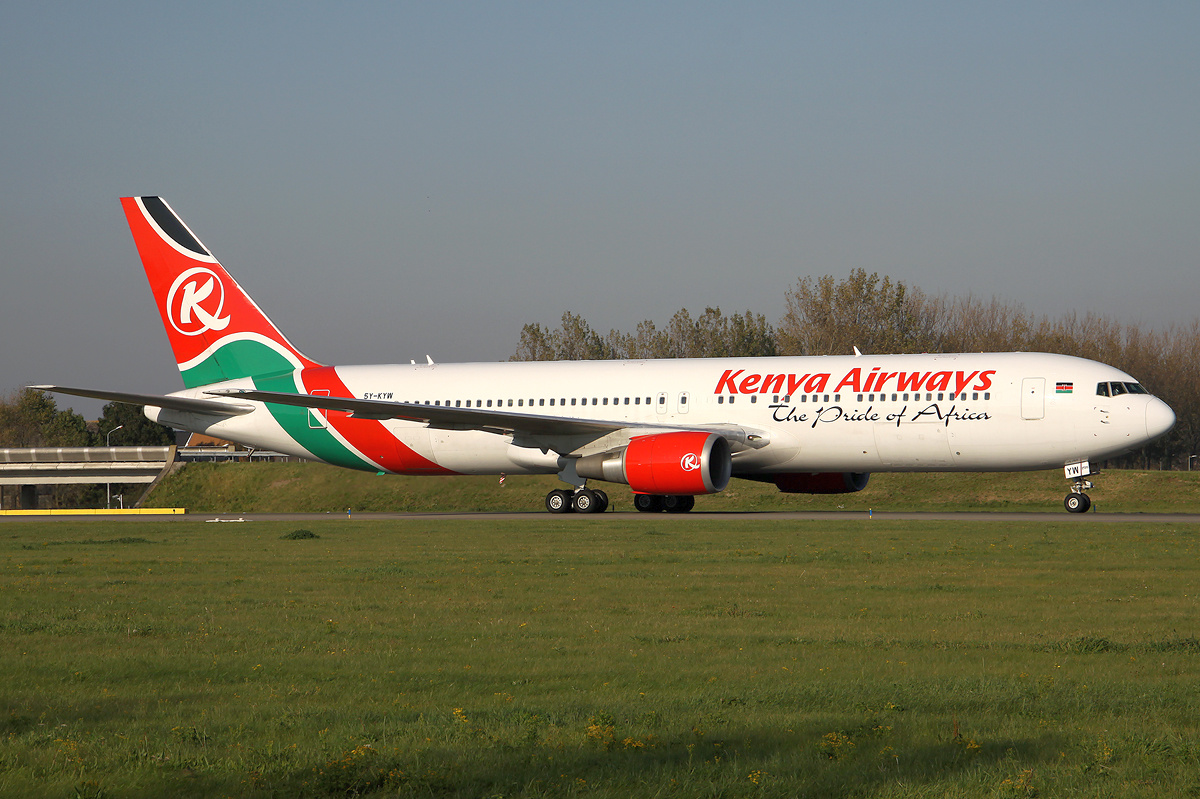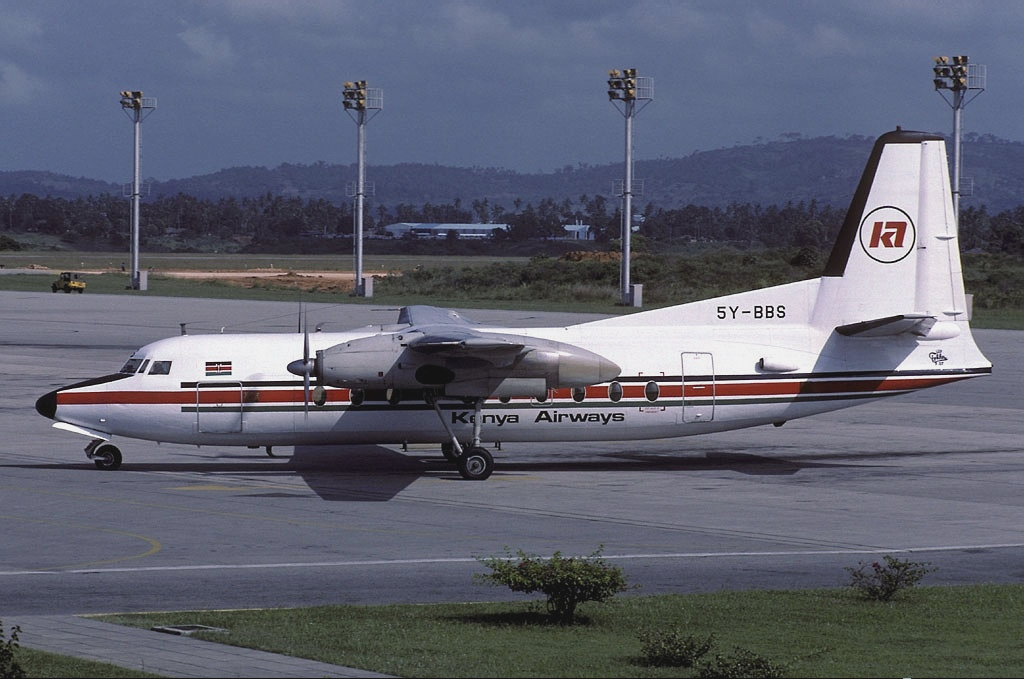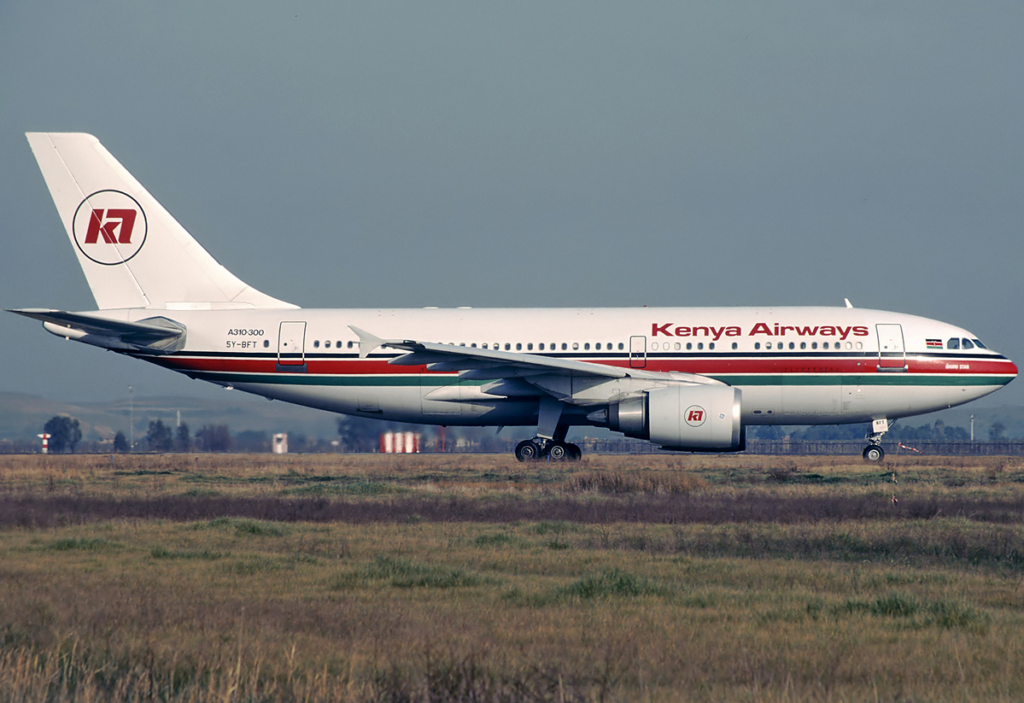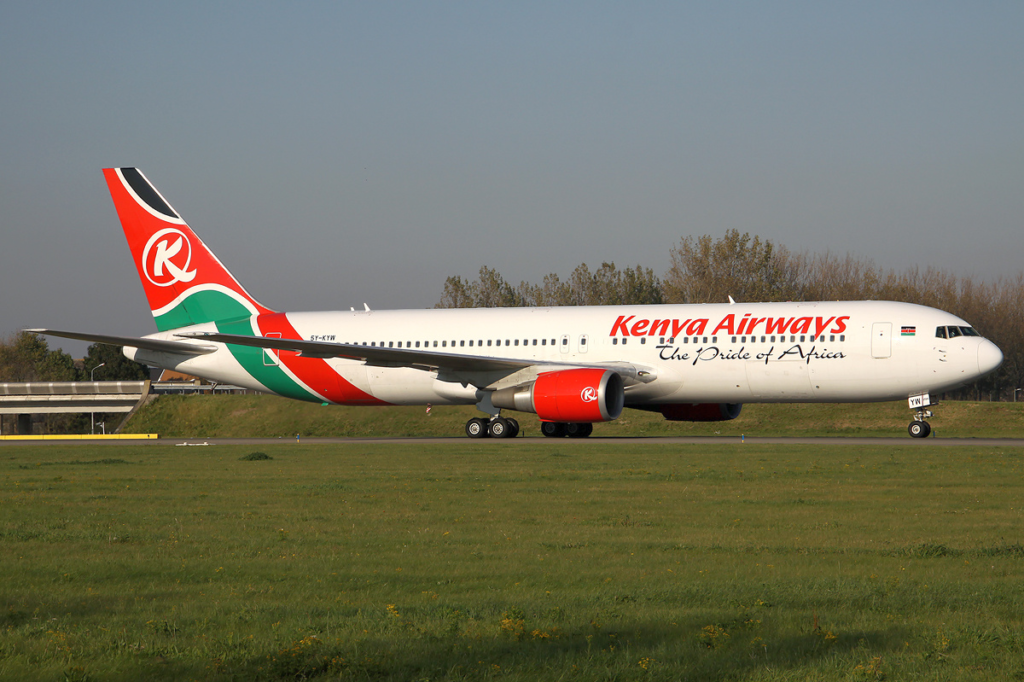
January 22, 1977: Kenya Airways was Established as a Wholly Government-owned Entity of the Republic of Kenya.
Kenya Airways Ltd., more commonly known as Kenya Airways, is the flag carrier airline of Kenya.[5] The company was founded in 1977, after the dissolution of East African Airways. Its head office is located in Embakasi, Nairobi,[6] with its hub at Jomo Kenyatta International Airport.[7]
The airline was owned by the Government of Kenya until April 1995, and it was privatised in 1996, becoming the first African flag carrier to successfully do so.[8] Kenya Airways is currently a public-private partnership. The largest shareholder is the Government of Kenya (48.9%), with 38.1% being owned by KQ Lenders Company 2017 Ltd (in turn owned by a consortium of banks), followed by KLM, which has a 7.8% stake in the company. Private owners hold the rest of the shares; shares are traded on the Nairobi Stock Exchange, the Dar es Salaam Stock Exchange, and the Uganda Securities Exchange.[8][9][10]
The airline became a member of SkyTeam in June 2010 and is also a member of the African Airlines Association since 1977.[11][12]
Early years
Kenya Airways was established by the Kenyan government on 22 January 1977, following the break-up of the East African Community and the consequent demise of East African Airways (EAA).[11][13][14] On 4 February 1977,[15]: 90 two Boeing 707-321s leased from British Midland Airways inaugurated operations,[16] serving the Nairobi–Frankfurt–London route.[17] On internal and regional flights, the carrier deployed aircraft formerly operated by the EAA consortium, such as one Douglas DC-9-52 and three Fokker F-27-200s.[17][nb 1] In late 1977, three Boeing 707s were acquired from Northwest Orient.[19] The following year, the company formed a charter subsidiary named Kenya Flamingo Airlines, which leased aircraft from the parent airline in order to operate international passenger and cargo services.[20] Aer Lingus provided the company with technical and management support in the early years.[21]
1980s–1990s: Expansion and privatisation

A Kenya Airways Fokker F27-200 at Moi International Airport in 1982.
In July 1980, the airline had 2100 employees and a fleet of three Boeing 707-320Bs, one Boeing 720B, one DC-9-30 and three Fokker F-27-200s. At this time, Addis Ababa, Athens, Bombay, Cairo, Copenhagen, Frankfurt, Jeddah, Kampala, Karachi, Khartoum, London, Lusaka, Mauritius, Mogadishu, Rome, Salisbury, Seychelles and Zürich were among the airline’s international destinations, whereas domestic routes radiated from Nairobi to Kisumu, Malindi, Mombasa and Mumias.[14] A Nairobi–Bombay nonstop route was launched in 1982 using Boeing 707-320Bs.[22] A year later, the company commenced serving Tanzania while flights to Burundi, Malawi and Rwanda were launched in 1984. Capacity on the European routes was boosted in November 1985 with the incorporation of an Airbus A310-200 leased from Condor. Kilimanjaro was first served in March 1986.[23] That year, the airline ordered two Airbus A310-300s. Kenya Airways was the first African carrier to acquire the type and was the first wide-bodies ordered by the company.[24] Funded with a US$20,000,000 (equivalent to $55,591,985 in 2023) loan,[25] the delivery of these two aircraft took place in May and September 1986.[23][26] They flew on the Kenya–Europe corridor, and permitted Kenya Airways to return the A310-200 to the lessor.[23] In early 1988, the carrier ordered two Fokker 50s;[27] for domestic routes, the airline received the first of these aircraft at the end of the year.[28] Also in 1988, the lease of a third A310-300 was arranged with the International Lease Finance for a ten-year period;[29] the aircraft joined the fleet in November 1989.[30] Leased from Ansett Worldwide, the first Boeing 757-200 was received in January 1990, whereas a third Fokker 50 was acquired in October the same year. By late 1991, two Boeing 737-200s had been leased from Guinness Peat Aviation.[30]

A Kenya Airways Airbus A310-300 at Fiumicino Airport in 1999. With registration 5Y-BFT, this particular aircraft entered the fleet in November 1989.[30]
In 1986, Sessional Paper Number 1 was published by the Government of Kenya, outlining the country’s need for economic development and growth. The document stressed the government’s opinion that the airline would be better off privately owned, thus resulting in the first privatisation attempt. The government named Philip Ndegwa as chairman of the board in 1991, with specific orders to make the airline a privately owned company. In 1992, the Public Enterprise Reform paper was published, giving Kenya Airways priority among national companies in Kenya to be privatised.[11] Ndegwa was succeeded by Isaac Omolo Okero. In September 1992, Brian Davies was appointed as the new managing director of the company.[30] Davies had been previously hired to carry out a study of viability on privatisation,[30] working for British Airways‘ Speedwing consulting arm.[31] Swissair was the first company to provide Kenya Airways with privatisation advice.[30] In the fiscal year 1993 to 1994, the airline produced its first profit since the start of commercialisation.[32] In 1994, the International Finance Corporation was appointed to assist in the privatisation process, which effectively began in 1995.[33] A large aviation industry partner was sought to acquire 40% of the shares, with another 40% reserved for private investors and the government keeping the remaining stake. The government would absorb almost US$90 million in debts and would convert another US$31 million it provided in loans into equity; after reorganisation, the company would have a debt of approximately US$78 million.[30] British Airways, KLM, Lufthansa and South African Airways were among the airlines expressing interest in taking a stake in Kenya Airways.[32][33][34]
KLM was awarded the privatisation of the company, which restructured its debts and made a master corporation agreement with KLM, which bought 26% of the shares, becoming the largest single shareholder since then.[33][35][36] Shares were floated to the public in March 1996, and the airline started trading in the Nairobi Stock Exchange.[37] The Government of Kenya kept a 23% stake in the company, and offered the remaining 51% to the public; however, non-Kenyan shareholders could hold a maximum 49% share of the airline.[33][35][36] Despite 40% of the shares being kept by foreign investors following privatisation (including KLM’s 26% stake), top management positions were held by Kenyans.[31] Following the takeover, the government of Kenya capitalised US$70 million, while the airline was awarded a US$15 million loan from the International Finance Corporation to modernise its fleet.[33] In a deal worth US$82 million, two Boeing 737-300s were ordered in July 1996.[38]
2000s–2010s
In January 2000, the airline experienced its first fatal accident when an Airbus A310 that had been bought new in 1986 crashed off Ivory Coast, shortly after taking off from Abidjan.[39][40] By April the same year, the fleet consisted of four Airbus A310-300s,[nb 2] two Boeing 737-200 Advanced and four Boeing 737-300s. At this time the company had a staff of 2,780, including 400 engineers, 146 flight crew and 365 cabin crew. From its main hub at Jomo Kenyatta International Airport, scheduled services were operated to Abidjan, Addis Ababa, Amsterdam, Bujumbura, Cairo, Copenhagen, Dar es Salaam, Douala, Dubai, Eldoret, Entebbe/Kampala, Harare, Johannesburg, Karachi, Khartoum, Kigali, Kinshasa, Lagos, Lilongwe, Lokichoggio, London, Lusaka, Mahe Island, Malindi, Mombasa, Mumbai, and Zanzibar.[15]: 90 In 2002, an order for three Boeing 777-200ERs was placed with Boeing; an additional aircraft of the type was acquired in November 2005.[41] In March 2006, six Boeing 787-8s were ordered; the first two examples would be delivered in 2010 and the rest in 2011.[42] The original Boeing 787 order was amended nine months later to include three more aircraft of the type.[43] The first Embraer 190 joined the fleet in December 2010.[44]

A Kenya Airways Boeing 767 in 2011.
In June 2012 the company announced the issuance of rights worth KSh.20 billion/=, aimed at increasing capital to support expansion plans.[45][46][47] Following the allocation of shares, KLM increased their stake in the company from 26% to 26.73%, while the Kenyan government boosted their participation into the company from 23% to 29.8%, becoming the largest shareholder.[48][49] In April 2012, the airline launched a plan named Project Mawingu (the Swahili word meaning Clouds) to add 24 destinations by 2021, including the start of services to Australia and North and South America, and expanding its presence in Asia as well.[50] In October 2013, the airline stated that it will add six new destinations every year, following the delivery of Boeing 777s and 787s the carrier has on order.[51]
Operational results for fiscal years 2015 and 2016 showed substantial losses.[52] The rapid expansion of the fleet and routes (dubbed “Project Mawingu”) was cited as the primary cause of the downturn. Fuel-price hedging and the 1996 agreement with KLM, considered intrusive in the running of the flag carrier, took secondary blame.[53] Corrective measures were taken to improve the financial and operational position of the airline and avert insolvency. The route partnership with KLM was deemed profitable thus, kept. However, the parties agreed to amend some features of the deal that hurt KQ –IATA code for Kenya Airways. Two Boeing B737-700 were sold and five newer, leased airliners were sub-leased to improve cash flow.[54] Efforts to financially re-position the carrier were successful at the end of 2017. In a complex deal, stakeholders agreed to convert close to half a billion US dollars in equity loans, changing the ownership structure. The government of Kenya, the biggest lender, saw its holdings rise from 29.8% to 48.9% while that of KLM was diluted from 26.7% down to 7.8%. A consortium of local banks, through a special-purpose vehicle called: “KQ Lenders Company 2017 Ltd.”, ended up with 38.1%. The latter entity is obligated with a loan from the above local banks for US$225 million; this amount, in turn, is guaranteed by the government. The airline’s employees, through a shareholding scheme, and others own the remaining 5.2%.[55] The Government of Kenya issued a guarantee for a further US$525 million debt owed to Import-Export Bank of the United States, financier of the newer Boeing planes of its fleet. In a bid to recover their exposure, syndicated leaseholders and banks unsuccessfully fought these measures to restructure the carrier’s ownership.[56]
An outline of a plan to restore profitability was disclosed in a March 2018 interview given by the CEO and the chairman of the company. The turnaround operation will include route expansion, pursuing the high-end segment of the market, on partnerships and joint ventures with other airlines.[57] The carrier plans to add up to twenty new destinations in Africa, Europe and Asia in the next five years. Five sub-leased aircraft are to re-join the fleet by the end of 2019 to facilitate this move.[58][57] Preparations are underway to roll out an economy-plus class to target the business and high-end leisure travellers. Direct flights to luxury tourism destinations in the Indian Ocean are also planned.[59] Talks are underway with South African Airways regarding route-sharing and aircraft-maintenance collaboration; this is the other focus of the turnaround scheme.[58] In December 2018 Kenya Airways revealed plans to start flights between Nairobi and Windhoek, Namibia.[60]
2020s and the current state of recovery.
The airline announced plans to undergo a $1 billion restructuring in 2021 to help it recover from the COVID-19 pandemic.[61] Upon announcing major losses in 2022, the carrier announced plans to cut ties with the Kenyan government by the end of 2023.[62]
In 2024, Kenya Airways has demonstrated a strong performance turnaround, marking its first profit since 2013, a significant milestone driven by its Project Kifaru strategy. This plan emphasizes operational excellence, financial discipline, and an enhanced customer experience. For the first half of the year ending June 2024, the airline reported a net profit of Ksh513 million, a major improvement from the Ksh21.7 billion loss reported during the same period last year The airline’s profit after tax saw a remarkable 102% improvement, highlighting the success of the ongoing recovery strategy.. Passenger numbers grew by 10% to 2.54 million, with an expanded capacity leading to a revenue increase of 22% to Ksh91 billion, The airline’s capacity, measured in Available Seat Kilometers (ASKs),increased by 16% to 7.991 billion ASKs, while Revenue Passenger Kilometers (RPKs) improved by14%.though cost management remains a challenge as operating expenses rose alongside growth in service capacity.[63]







